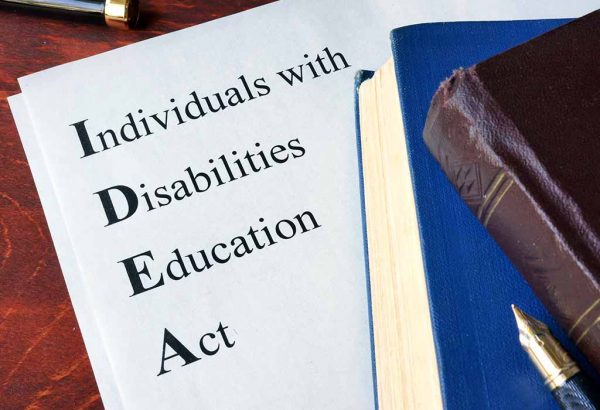If your child has an Individualized Education Program (IEP), they have special protections in the event that their school attempts to remove them from the classroom after a disciplinary violation. Read here for more information. //
Most students misbehave from time to time. Lack of foresight, poor judgment, the inability to regulate big emotions, and impulsivity are hallmarks of youth, regardless of whether the students has any special needs. One need only scratch the surface of modern research on adolescent brain development to understand the consequences of an undeveloped prefrontal cortex, which is crucial for the ability to regulate thoughts and behaviors. However, there are times when a student’s conduct may look like misbehavior, but that conduct is actually rooted in the student’s disability. The Individuals with Disabilities Education Act (IDEA) recognizes that students with disabilities should not be punished for conduct that is related to their disability. IDEA provides special due process protections for students with recognized disabilities and requires schools to determine whether the presenting behavior is a manifestation of a student’s disability before it may move forward with certain disciplinary actions. If the offending behavior is a manifestation of the student’s disability, the or she may not be suspended for more than 10 days or expelled for that behavior.
Discipline for Special Education Students
Generally, misbehavior in a school setting is defined as any violation of the school’s student conduct code, which includes violations of state and federal law. More routinely, misbehavior involves classroom disruptions, disobeying authority, and interpersonal conflict with other students. The disciplinary provisions of IDEA spell out the authority of school personnel to remove protected students from the student’s current placement when he or she violates the student conduct code. IDEA requires that all students with disabilities, including those who are suspended or expelled, be provided a Free Appropriate Public Education (FAPE). 20 USC 1412(a)(1)(A). School personnel have the authority to remove a student for misconduct from the student’s current placement to an interim alternative setting, another setting, or through suspension. This initial removal may not exceed 10 days.
If the school district intends on removing a student for more than 10 days, the district will have to provide educational services for the student in accordance with FAPE. If the student is removed for more than 10 days, this is considered a “change in placement.” This also occurs if the student “has been subject to a series of removals that constitute a pattern.” 34 CFR 300.536. A series of removals are a pattern if they: (1) total more than 10 school days in a year, (2) the student’s behavior is substantially similar to his behavior in previous incidents when he was removed, and (3) considering other factors like the length of each removal, the total amount of time the student has been moved, and the proximity of the removals to one another, there appears to be a pattern of removing the student. 34 CFR 300.536(a)(2).
Manifestation Determination
If there is a change in placement, the school must (1) do a manifestation determination, (2) provide an educational program, and (3) as appropriate, provide a functional behavioral assessment and behavioral intervention services and modifications. The manifestation determination is made by the school district, the parents, and relevant members of the IEP team. The student may be represented by an attorney at the hearing. Typically, the student does not attend, and his or her attendance is not advised given the nature of the information shared during the hearing.
Two issues are covered at a manifestation determination (34 CFR 300.530(e)):
1. Was the student’s conduct caused by, or directly and substantially related to, the student’s disability?
2. Was the student’s conduct the direct result of the school’s failure to implement the IEP?
If the answer to both of these questions is “no,” the student may be disciplined like any other student. Unless special circumstances exist, if the student’s behavior is determined to be a manifestation of the student’s disability, the student is returned to his current placement. The school must also conduct a functional behavior assessment (FBA) to determine why the student is acting in a disruptive manner. A behavioral intervention plan (BIP) is created to address the student’s problematic behaviors using methods that do not involve removal from school.
Challenging the Manifestation Determination
In a manifestation determination meeting, the school will likely take the position that the student’s behaviors are not a manifestation of his disability and/or not the result of the school’s failure to properly implement the IEP. Parents who are opposed to continued removals of their child from school are often especially opposed to expulsion and will attribute their child’s behavior to the disability and/or the failure of the school to implement the IEP.
When disagreement arises between a student’s parents and the school, parents have two powerful tools at their disposal: they can either file a complaint with the Colorado Department of Education (CDE) or request a due process hearing before an administrative law judge (ALJ). Schools generally seek to avoid either a complaint or a due process hearing.
Complaints are not the ideal instruments for dealing with disagreements involving manifestation determinations. The CDE has 60 days to resolve the complaint, but has no jurisdiction to rule on the findings of a manifestation determination. Complaints normally are meant to address institutional problems rather than individual problems. However, there is nothing precluding a complaint for individual problems, and filing a complaint with the CDE can be effective in getting schools to negotiate.
Like trials, due process hearings to resolve conflicts over matters like manifestation determinations can be very costly for schools. Once a request for a hearing has been made, the hearing must commence before an ALJ within 20 school days from the date the complaint is filed. 34 CFR 300.530(g). The ALJ must render a decision within 10 days from the conclusion of the hearing. The ALJ decision addresses whether the student’s behavior was a manifestation of her disability and/or the result of the school district’s failure to properly implement the IEP.
Once a complaint or a request for a due process hearing is filed, parents and schools still have the opportunity to resolve their differences through mediation. Mediation can be very effective. In addition to the rights that special education students possess, they have the same rights that general education students have in state courts. The protections under IDEA are more effective in resolving special education student disciplinary disputes than using the limited protections of the School Attendance Law of 1963.
Still have questions about the disciplinary process for students with disabilities? Led by partner Lindsay Brown, the school discipline team at Meilstrup & Brown is experienced and well-equipped to lead you through this difficult and important process. Reach out today for a free case consultation. Lindsay@meilstrupbrown.com


